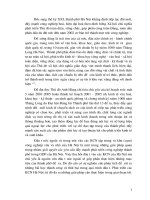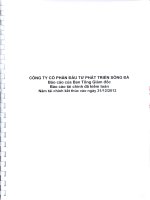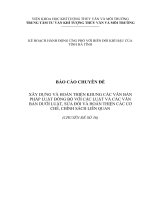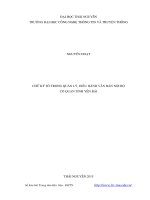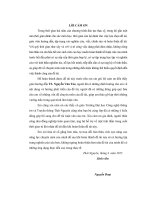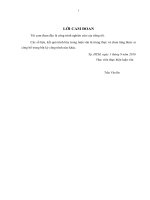bộ chuyển đổi phông chữ được phát triển bởi AhaChat
Bạn đang xem bản rút gọn của tài liệu. Xem và tải ngay bản đầy đủ của tài liệu tại đây (3.36 MB, 108 trang )
A STUDY TO ASSESS THE EFFECTIVENESS OF POVIDONE-IODINE SITZ BATH
VERSUS LAVENDER OIL SITZ BATH ON EPISIOTOMY PAIN AND WOUND
HEALING AMONG POSTNATAL MOTHERS UNDERGONE VAGINAL DELIVERY
IN TERTIARY CARE SETTINGS, COIMBATORE
By
ANITHA.P
A Dissertation submitted to The Tamil Nadu Dr.M.G.R. Medical University,
Chennai, in partial fulfillment for the requirement of the degree of
Master of Science in Nursing
Branch III Obstetrics and Gynecological Nursing
2018
A STUDY TO ASSESS THE EFFECTIVENESS OF POVIDONE-IODINE SITZ BATH
VERSUS LAVENDER OIL SITZ BATH ON EPISIOTOMY PAIN AND WOUND
HEALING AMONG POSTNATAL MOTHERS UNDERGONE VAGINAL DELIVERY
IN TERTIARY CARE SETTINGS, COIMBATORE
Proposal presentation on: 11.05.2017
Approved by the dissertation committee on: 30.08.2017
Signature of the Clinical
Specialty Guide
…………………………………………………………..
PROF. SREERENJINI.B, M.Sc (N).,
Professor & HOD,
Department of Obstetrics and Gynaecological Nursing,
PSG College of Nursing,
Peelamedu,
Coimbatore-641004.
Signature of the Medical Guide
…………………………………………………………..
Dr. SEETHA PANIKER, DGO, MD, DNB.,
Professor & HOD,
Department of Obstetrics and Gynaecology,
PSG Hospitals,
Peelamedu,
Coimbatore-641004.
Signature of the Principal
…………………………………………………………..
Prof. Dr. A. JAYA SUDHA, M.Sc (N), Ph.D.,
Principal,
PSG College of Nursing,
Peelamedu,
Coimbatore-641004.
Signature of the Internal Examiner
Date:
Signature of the External Examiner
Date:
CERTIFICATE
Certified that A STUDY TO ASSESS THE EFFECTIVENESS OF POVIDONEIODINE SITZ BATH VERSUS LAVENDER OIL SITZ BATH ON EPISIOTOMY PAIN
AND WOUND HEALING AMONG POSTNATAL MOTHERS UNDERGONE VAGINAL
DELIVERY IN TERTIARY CARE SETTINGS, COIMBATORE is the bonafide work of
ANITHA.P, PSG College of Nursing, Coimbatore, and submitted in partial fulfillment of
requirement of the degree of Master of Science in Nursing to The Tamil Nadu Dr. M.G.R
Medical University, Chennai under the register number 301620801.
College Seal
Signature of the Principal
……………………………………………..
Prof. Dr. A. Jaya Sudha, M.Sc (N), P.hD.,
Principal,
PSG College of Nursing,
Peelamedu,
Coimbatore-641004
ACKNOWLEDGEMENT
‘‘I will praise you, lord, with all my heart.,
I will tell of all your wonders’’
My heartfelt praises to God almighty for his enriched blessing and abundant grace and
mercy which encircled me through every step of this work and convert this work into reality and
without whom it would not have been possible. I thank him exceedingly for giving the required
courage from the beginning till the end.
I have been fortunate in having received the cooperation and guidance of many peoples in
completing this research. I consider it a privilege to acknowledge here the help and guidance
extended by each one of them.
I wish my sincere thanks to our Managing Trustee for all the facilities which has been
provided to us in the institution.
With deep sense of gratitude, I express my sincere thank to Dr. A. Jaya Sudha, Principal
and Dr. Malarvizhi .G, Vice Principal PSG College of Nursing. The words of appreciation and
encouraging support given by her kindled my spirit and enthusiasm to go ahead and to
accomplish this study successfully.
I wish to extend my whole hearted thanks to my subject guide Prof. Sree Renjini. B,
HOD of Obstetrics and Gynecological Nursing Department, PSG College of Nursing. Thank you
madam for your motherly attitude, dexterous and expert guidance, valuable suggestions,
affectionate enduring support, timely motivation and enthusiasting words which kept me
working, towards the completion of this successful dissertation. I feel extremely privileged to
have her as my guide.
I am extremely thankful to Dr. Seetha Paniker, Professor and head of the department of
Obstetrics and Gynecology, PSG Hospital, Coimbatore for her acceptance as my medical guide,
abiding support and expert guidance to complete my study successfully.
I would like to express my sincere, respectful and wholehearted gratitude to Faculty of
OBG department for their unstinting support and guidance during the writing of this project.
I proudly and honestly express my grateful thanks to The entire faculty of PSG College
of Nursing for their valuable feedback and suggestions for the study.
I submit my extreme gratefulness to statistician Dr. Karthikeyan, Assistant Professor for
their excellent advice and support in analyze the data and immense correction and clarification.
I express my sincere gratitude to the Ethical committee of the PSG Institution for their
valuable suggestion and approval for the study being conducted.
I express my sincere thanks to all library staffs for rendering all facilities and support
during the time of this study.
I thank sincerely all the Staff Nurses working in OG ward, PSG Hospitals, for their kind
help and co-operation throughout my study period.
I also acknowledge and appreciate the work of Mr. Mohan cool blue, Coimbatore for
their patience and cooperation in typing and timely help throughout my study.
I take this opportunity to express my thanks to all my Classmates who have been a
source of encouragement and support during the course of this work.
Above all, I express my heartfelt unexplained thanks to my parents Mr. Periasamy.S,
Mrs. Manimekalai.P, my lovable sister Mrs. Sulakchana.N, my Beloved Brother
Mr. Surendar.P and Mr. Anbalagan.V, who are the source of inspiration, encouragement, and
support through their constant help in every walk of my life as now for the completion of this
study.
I continue to be indebted to all for their support, guidance and care who directly and
indirectly involved in my progress of work and for the successful completion of the thesis.
LIST OF CONTENTS
CHAPTERS
TITLE
PAGE NO.
ABSTRACT
CHAPTER I
INTRODUCTION
1
1.1
Background of the study
1
1.2
Need for the study
5
1.3
Statement of the problem
7
1.4
Objectives
7
1.5
Assumption
8
1.6
Hypothesis
8
1.7
Delimitations
8
1.8
Operational definitions
9
1.9
Projected outcome
10
1.10
Conceptual framework
10
REVIEW OF LITERATURE
13
2.1
Evidence based episiotomy and its care
13
2.2
Studies related to episiotomy and its prevalence
15
2.3
Studies related to episiotomy wound healing
17
2. 4
Studies related to effectiveness of Lavender oil sitzbath and
18
CHAPTER II
Povidone-Iodine sitzbath on episiotomy wound healing
2.5
Studies related to episiotomy pain reduction
CHAPTER III MATERIALS AND METHODS
21
25
3.1
Research Approach and Design
25
3.2
Variables of the study
26
3.3
Setting of the study
26
3.4
Population and sampling
27
3.5
Instruments and tools for data collection
28
3.6
Ethical approval
33
3.7
Report of pilot study
33
3.8
Data analysis plan
34
CHAPTER IV DATA ANALYSIS AND INTERPRETATION
4.1
Frequency and percentage distribution of Demographic and
35
36
Obstetrical variables among postnatal mothers
4.2
Assessment of episiotomy pain and wound healing among
43
postnatal mothers
4.3
Effectiveness of Povidone-Iodine sitzbath and Lavender oil
47
sitzbath on episiotomy pain and wound healing among
postnatal mothers undergone vaginal delivery with
episiotomy
4.4
Comparison of the effect of Povidone-Iodine sitzbath and
51
Lavender oil sitzbath on episiotomy pain and wound healing
among postnatal mothers undergone vaginal delivery with
episiotomy between experimental group I and II
4.5
Correlation between episiotomy pain and wound healing
54
among postnatal mothers undergone vaginal delivery with
episiotomy after sitzbath
4.6
Association between the level of episiotomy pain and wound
55
healing with selected demographic variables among postnatal
mothers
CHAPTER V
RESULTS AND DISCUSSION
59
5.1
Demographic and Obstetrical profile of the mother
60
5.2
Assessment of episiotomy pain and wound healing among
61
postnatal mothers
5.3
Effectiveness of Povidone iodine sitzbath and Lavender oil
61
sitzbath on episiotomy pain and wound healing between
experimental group I and II
61
5.3.1
Effectiveness of Povidone iodine sitzbath on episiotomy pain
and wound healing (Experimental group I)
5.3.2
Effectiveness of Lavender oil sitzbath on episiotomy pain and
wound healing (Experimental group II)
62
5.4
Compare the effectiveness of Povidone iodine sitzbath and
62
Lavender oil sitzbath on episiotomy pain and wound healing
among postnatal mothers.
5.5
Correlation between the episiotomy pain and wound healing
63
after sitzbath among postnatal mothers
5.6
Association between the level of episiotomy pain and wound
64
healing among postnatal mothers with their selected
demographic variables
CHAPTER VI SUMMARY AND CONCLUSION
65
6.1
Major findings of the study
66
6.2
Conclusion
67
6.3
Nursing implications
68
6.4
Limitations
69
6.5
Suggestion
69
6.6
Recommendations for future study
69
BIBLIOGRAPHY
70
ANNEXURE
74
LIST OF TABLES
TABLES
TITLE
PAGE NO.
4.1
Demographic and Obstetrical variables of postnatal mothers
36
4.1.1
Frequency and percentage distribution of postnatal mothers
36
according to their socio-demographic variables
4.1.2
Frequency and percentage distribution of Obstetrical variables
40
among postnatal mothers
4.2
Assessment of episiotomy pain and wound healing among
43
postnatal mothers
4.2.1
Frequency and percentage distribution of level of episiotomy pain
43
among postnatal mothers
4.2.2
Frequency and percentage distribution of level of wound healing
45
among postnatal mothers
4. 3
Effectiveness of Povidone-Iodine sitzbath and Lavender oil
47
sitzbath on episiotomy pain and wound healing among postnatal
mothers
4.3.1
Comparison of mean and standard deviation of Episiotomy pain
47
between pre test and post test scores among Experimental group I
4.3.2
Comparison of mean and standard deviation of Episiotomy pain
48
between pre test and post test scores among Experimental group II
4.3.3
Comparison of mean and standard deviation of Episiotomy wound
49
healing between pre test and post test scores among Experimental
group I
4.3.4
Comparison of mean and standard deviation of Episiotomy wound
50
healing between pre test and post test scores among Experimental
group II
4.4
Comparison of posttest level of Povidone-Iodine sitzbath and
Lavender oil sitzbath on episiotomy pain and wound healing
among postnatal mothers undergone vaginal delivery with
episiotomy between experimental group I and II
51
4.4.1
Comparison of mean and SD of posttest level of episiotomy pain
51
between experimental group I and experimental group II scores
among postnatal mothers
4.4.2
Comparison of mean and SD of posttest level of episiotomy
52
wound healing between experimental group I and experimental
group II scores among postnatal mothers
4.5
Correlation between episiotomy pain and wound healing among
54
postnatal mothers undergone vaginal delivery with episiotomy
after sitzbath
4.5.1
Correlation between the posttest of episiotomy pain and wound
54
healing among postnatal mothers towards Povidone-Iodine
sitzbath
4.5.2
Correlation between the posttest of episiotomy pain and wound
54
healing among postnatal mothers towards Lavender oil sitzbath
4.6
Association between pretest level of episiotomy pain and wound
55
healing with selected demographic variables among postnatal
mothers
4.6.1
Association between pretest level of episiotomy pain with selected
55
demographic variables
4.6.2
Association between pretest level of episiotomy wound healing
with selected demographic variables
57
LIST OF FIGURES
FIGURES
1.1
TITLE
Conceptual framework: Modified Lydia Hall’s Core, Care, Cure
PAGE NO
12
Model for episiotomy pain reduction and enhances wound healing
3.5.3
4.1.1.1
Schematic representation of data collection procedure
32
Clustered column diagram Shows the age in years among
39
postnatal mothers between experimental group I and II
4.1.1.2
Clustered column diagram shows the obstetrical score, mode of
39
delivery and previous type of delivery among postnatal mothers
between experimental group I and II
4. 1.2.1
Stacked bar diagram shows the length, number and indications of
42
episiotomy among postnatal mothers between experimental group
I and II
4.1.2.2
Stacked bar diagram shows the self perineal care and changing of
42
perineal pad among postnatal mothers between experimental
group I and II
4.2.1.1
Stacked column diagram shows the level of episiotomy pain in
44
experimental group I
4.2.1.2
Stacked column diagram shows the level of episiotomy pain in
44
experimental group II
4.2.2.1
Stacked column diagram shows the level of episiotomy wound
46
healing in experimental group I
4.2.2.2
Stacked column diagram shows the level of episiotomy wound
46
healing in experimental group II
4.4.1
Line graph shows that the mean value of Numerical Pain Rating
53
scale regarding episiotomy pain in both experimental group I and
II
4.4.2
Line graph shows that the mean value of REEDA scale regarding
episiotomy wound healing in both experimental group I and II
53
LIST OF ANNEXURES
ANNEXURE
TITLE
PAGE NO
I
Permission letter
74
II
Institutional human ethics committee letter
77
III
Consent form
79
IV
Tool
85
V
Intervention
92
VI
Master coding sheet
95
ABSTRACT
A study to assess the effectiveness of Povidone-Iodine sitzbath versus Lavender oil sitzbath on
episiotomy pain and wound healing among postnatal mothers admitted in tertiary care setting,
Coimbatore.
Background of the study: Motherhood is a beautiful process, Where by mothers safely delivers a child.
It is the magic of creation. During child birth, the women may sustain some degree of perineal trauma due
to perineal tear or surgical incision called episiotomy.The care of episiotomy is an important aspect of
postnatal care. One of the suggested methods is a regular antiseptic sitzbath. Nowadays, using alternative
and complimentary therapies such as Lavender oil in aromatherapy have been recognized in obstetrics. It
has antibacterial, antifungal, sedative, antidepressant and healing properties. One of the main action of
these oils are easy absorption through the skin. However, definitive effects of these methods have not
been verified through clinical trials, and more extensive studies are still required in this area.
Objective: The main objective of the study was to assess the effectiveness of Povidone-Iodine sitzbath
versus Lavender oil sitzbath on episiotomy pain and wound healing and thereby improving their physical
wellbeing.
Methods: The research design adopted was Quasi experimental, time series design. Totally 50 postnatal
mothers were selected by purposive sampling method. In this experimental group I consisted of 25
postnatal mothers receiving Povidone-Iodine sitzbath and experimental group II consisted of 25 postnatal
mothers receiving Lavender oil sitzbath. The study was conducted in postnatal ward, PSG Hospital.
Those who were fulfilled the inclusion criteria were selected for this study. The socio demographic and
obstetrical profiles were collected through face to face interview and from records. The episiotomy pain
was assessed during walking, sitting, changing position, urination and defecation through Numerical pain
rating scale and wound healing was assessed through REEDA scale. Pretest was assessed after 2hrs of
vaginal delivery with episiotomy and interventions sitzbath given to the both group in morning and
evening for 20 minutes duration with 12 hours interval till discharge by using Povidone-Iodine solution
and Lavender oil solution. Then the posttest was assessed after 24hrs, 48hrs and 72hrs.
Result of the study: Effectiveness of Povidone-Iodine sitzbath and Lavender oil sitzbath on episiotomy
pain and wound healing results showed that the overall mean with SD (4.5420 ± 0.4163, 5.30 ± 0.76) is
in experimental group II which is lesser than the mean with SD of (5.5700 ± 0.4524, 6.48 ± 0.84)
experimental group I. Thus the results showed that Lavender oil sitzbath is effective to reduce the
episiotomy pain and promote wound healing when compared to Povidone-Iodine sitzbath. Whereas in
correlation between the posttest of episiotomy pain and wound healing in experimental group I (r=0.41)
and group II (r=0.5416). It reveals that there is positive and moderate correlation. There was no
significant association between the pretest level of episiotomy pain and wound healing with their selected
demographic variables among postnatal mothers in both experimental group I and II.
Conclusion: The study concludes Lavender oil sitzbath is effective in episiotomy wound healing and
reduction in pain perception compared to Povidone-Iodine sitzbath.
Key words: Episiotomy pain, episiotomy wound healing, Povidone-Iodine sitzbath, Lavender oil
sitzbath, postnatal mothers.
CHAPTER-I
INTRODUCTION
1.1 Background of the study
“Birthing is the most profound initiation to spirituality a woman can have”
(Robin Lim)
Pregnancy and child birth are special events in women‟s lives. Birthing is normal, the
moment of birth is both joyous and beautiful. The physiological transition from pregnancy to
motherhood heralds an enormous change in woman, physically and psychologically.
Accompanying the physical changes are feeling of great intensity varying from excited
anticipation, to fearful expectancy (Kat E., 2006)
Child birth through vaginal mode seems to be the safest mode for the majority of women.
The perineum is a very important part of a woman‟s body and it plays a special role during child
birth. Perineum is the area of skin and muscle found between the vagina and anus. During child
birth, the perineum stretches to allow the baby‟s head through.
During a normal vaginal birth, the fetal head exerts significant pressure on the tissues of
the perineum and vaginal vault. Some women seem to have tissue that tears easily, even with a
small baby and apparently easy birth, others will give birth over intact perineum, inspite of large
babies or unusual presentations (Judith Kurokawa., 2000).
During childbirth, the women may sustain some degree of perineal trauma due to perineal
tear or surgical incision called episiotomy. Episiotomy is performed on millions of women every
year. Episiotomy is the most common perineal incision in obstetrics and midwifery. It was first
used in normal deliveries in 1742. However, it did not become common until the early 1900‟s
when the shift from home to hospital delivery. The popularity of episiotomy among obstetricians
continued to grow with the introduction of anesthetic and suture material and as a result of
advocacy for its performance by two obstetricians, Delec and Pomerocy (Maior., 1997)
1
The rationale for episiotomy use depends largely on the need to minimize the risk of
severe spontaneous, maternal trauma and to speed up delivery, and to minimize fetal distress.
(Carroli Belizen and Stamp., 1999)
The routine use of episiotomy decreases the risk of moderate anterior perineal laceration,
and reduces the chance of perineal tears. (Panel et al., 2007)
The incidence of episiotomy is increased in the following circumstances primiparity,
Asian women, forceps and vacuum deliveries (Murphy, Maureen., 2007)
The outcome of episiotomy is found that delayed wound healing due to wound separation
or clinical infection (Mary McGuiness and Kathleen., 2005)
Episiotomy is commonly performed in USA to prevent obstetric perineal lacerations.
(Leveno KJ, Bloom SL, et al., 2005)
The routine use of episiotomy harmful to the pelvic floor, that creates greater extent of
surgical incision and delayed perineal wound healing, compared with no episiotomy group.
(Kathleen and Karla., 2005)
Continuous improvement in quality of care after episiotomy could helps to controls the
infection and improves episiotomy wound healing (Faruel F H and Ventlttelli F., 2007)
The care of episiotomy is an important aspect of postnatal care. Studies suggest that using
episiotomy in normal delivery results in fewer perineal laceration and trauma. Wound healing is
complex and requires safe and effective treatment modalities. Attention should be afforded to
episiotomy wound care since it parallels any other wound. One of the suggested methods is a
regular antiseptic sitzbath. (Lowdermilk D L, Perry SHE., 2003)
The application of water externally to the body for therapeutic effect is practice called
Hydrotherapy or water therapy. One of the most popular methods of using hydrotherapy is the
sitz bath originating in Germany; a sitzbath is natural method of soaking in very warm water.
Doing this repeatedly is said to stimulate the lymphatic system, increase circulation and remove
toxins. (Mc Guinas., 2004)
2
Sitzbath is the form of water bath, which is coming back into popularity as a low risk.
Sitzbath term comes from the German verbs „sitzen‟ meaning to „sit‟. The sitzbath is a European
tradition in which only the pelvis and abdominal area are placed in the water. It helps for women
after child birth whether or not had an episiotomy.
Povidone-Iodine is an antiseptic that is widely used in Iran for surgical and skin wounds.
All midwives and obstetricians apply Betadine for postpartum care. To date no study about
Betadine and its side effects in Iran. In a study that compared the effectiveness of Betadine and
waters, no significant difference was found between the two groups in wound healing. (Zahrani
Sh Tork., 2002)
Various studies have provided evidence that Povidone-Iodine does not promote wound
healing, and even impair wound healing, reduce wound strength or cause skin reactions. Cooper
et al. showed that povidone-iodine with a dose dependent manner can suppress function of
fibroblasts and lymphocytes. (Cooper M L, Laxer J A., 1991)
Nowadays, using alternative and complementary therapies such as essential oils in
aromatherapy have been recognized in obstetrics. Aromatherapy used healing effects of volatile
essential oils on the body in different ways. (Burns E, Blamey C., 2000)
Pharmacological impacts of each essential oil differ regarding to their chemical
composition, principal constituents, country of origin and method of extraction. Mechanism of
action of each essential oil is related to its complex active substances. One of the means of action
is the aroma of these oils sent as a signal to the olfactory bulb which has close anatomical ties to
the limbic system. The limbic system is the emotional center of the brain, where all major
emotional expressions are generated. The limbic system influences the endocrine and the
autonomic nervous system. Another mechanism is absorption through the skin. The molecules of
essential oils and carrier oils are small enough to permeate through the skin barrier. Skin
absorption can be via massage, bath, foot bath and hot or cold compresses. The molecules will be
absorbed easily into the skin within 20 to 40 minutes depending on the chemical nature of the oil.
(Habanananda T., 2004)
3
Lavandula stoechas (Lamiaceae) or Lavender is one of the plants with aromatic leaves
and attractive bracts at the top of flowers. It grows in western Mediterranean countries, the
Atlantic islands, Turkey, Pakistan and India. (Staicov V, Chingova B., 1969)
The flowers, and the essential oil derived from them are antibacterial, antifungal,
sedative, anti-depressive and effective for burns and insect bites. Lavender has carminative
(smooth muscle relaxing), anti-flatulence and anti-colic properties in aromatherapy. (LisBalchin M, Hart S., 1999)
In traditional medicine, L. stoechas has been used as carminative and antispasmodic for a
long time. Lavender inhibits potassium induced contractions in a dose dependent manner like
Channel blockers such as Verapamil. (Adam K, Sivropoulou A., 2000)
Alpha-terpineol and terpinen-4-ol and camphor are the chemical constituents of Lavender
essential oil that have antibacterial effects. Alpha-pinene, beta-pinene and p-cymene are other
substances that have antifungal activity. Carvacrol, terpinen-4-ol, linalool, sabinene, a-terpinene,
and g-terpinene which are in Lavendula Stoechas are effective in some Gram-negative and
Gram-positive bacteria and three pathogenic fungi. b-pinene (39.7%), a-pinene (10.9%) and
camphor (9.7%) were the main components of Salvia tomentosa (Miller) oil which are
antioxidant and antimicrobial. Antibacterial activity of P-cymene, cryptone or thymol has been
suggested as the most potent inhibitor of Pseudomonas aeruginosa growth. (Cimanga K and
Kambu K., 2002)
The use of lavender oil for perineal healing was first investigated by Dale and Cornwell
in 1994 and has not been replicated to date. They conducted a clinical trial on 635 women using
lavender oil and placebo following normal vaginal delivery for perineal healing. In this study
mean discomfort score was lower in women using lavender oil with no significant side effects
reported. This study aims to assess the effects of Lavender oil and Povidone-Iodine sitzbath on
episiotomy pain and wound healing. (Cornwell S and Dale A., 1995)
4
1.2 Need for the study
The postnatal period refers to 6 weeks period after childbirth. The period is popularly
termed the fourth trimester of pregnancy. It comprises an amazing variety of complex
physiologic and psychological adaptations. The physical care of a women receives during the
postnatal period can influence her health for the rest of her life. The nurse‟s role is vital as she
assists the mothers through these adjustments and supports them as they make a fresh start as a
new family. Postnatal women are more prone for puerperal infection as a result of episiotomy
which can be prevented by proper postnatal care.
In India the incidence of episiotomy is also very high (70%) per thousands births (2016).
Pain following episiotomy appears to be universal. The mother who is undergone episiotomy is
characterized by greater blood loss in conjugation with delivery, and there is a risk of improper
wound healing and increased pain during early puerperium.
Episiotomy is just one of the practices that contributes to the supposed “ harm of vaginal
birth” as more women in developing countries deliver their babies in hospitals. Episiotomy can
be associated with extension or tear into the muscle of the rectum or even the rectum itself and
may also lead to infection, bleeding, swelling, defects in wound closure, local pain and a short
term possibility of sexual dysfunction.
Episiotomy pain often interferes with basic daily activities for the woman such as
walking, sitting, passing urine and defecating and also negatively impacts on motherhood
experiences.
Seven randomized controlled trials of liberal versus restrictive use of episiotomy assessed
pain outcome. The most common primary outcome was perineal status after the birth. All seven
studies reported incidences of episiotomy in liberal use and in restrictive it was third and fourth
degree lacerations or extensions. The most common secondary outcome was pain in the days
immediately after the birth. In the two groups used Numerical pain scale to assess the pain and
classified responses into categories of mild, moderate or severe. Orally they have reported the
composite score of the 0-10 item scale. Thus pain assessment is very important contributor for
professionals especially midwives, as traditionally they are left to manage the episiotomy wound.
5
The world health organization has taken a clear stand against routine episiotomy. The
episiotomy infections are preventable and can be reduced by practicing clean delivery and
effective postnatal care. Midwives have an important role in the care of episiotomy wound after
child births (WHO statistics, 2007)
There are several common methods used for reducing pain and accelerating the
episiotomy-healing process. Nonsteroidal anti-inflammatory drugs are among the typical
medications used to reduce episiotomy pain, though they may cause some side effects such as
peptic ulcers.
Sitzbath is a simple and cost effective and easy method of treating episiotomy wound.
Sitzbath is the form of hydrotherapy to relieve discomfort and promote physical well being. Aua,
Saxton, and Sue Markwell, (1998) stated that experimentally proved that sitzbath plays an
important role in providing the thermal and mechanical effects and administering the curative
treatment. The powerful thermic impressions transmitted inward and by the profound vascular
impression made through the dilatation of the surface vessels, heat production, the oxidation of
nitrogen, and metabolism are quickened under the influence of the elevated temperature of the
water. The effect is to enhance the pelvic circulation and to reduce swelling tissues, itch and
soothe sore vaginal tissues and helps in episiotomy healing. Medicated herbs and antiseptic
solutions can also added in the sitzbath to reduce the growth of bacteria and enhance healing. As
its takes less time.
Sitzbath is not a routine practice in our OG ward settings in spite of it being cost effective
and less time consuming. During this procedure care giver can talk and communicate with the
mothers which may reduce the fear and may relieve the pain and increases comfort, during the
postnatal days. The postnatal mother can do this independently in the home settings when they
get discharged from the hospitals following the delivery.
Betadine (Iodine) is also commonly used to prevent infection and help with healing of the
episiotomy wound. However, various studies show that it has no significant effect on
Microorganism-reduction. Many women find the current available methods unsatisfactory and
are looking for other effective and safe options.
6
Nowadays using complementary therapies such as essential oils have been recognized in
obstetrics. Lavender oil is one of the essential oil due to its antibacterial, antifungal, sedative,
antidepressant and healing properties. One of the main action of these oils are easy absorption
through the skin. So Lavender oil can be used in a sitzbath and it would also have the added
benefit of decreasing anxiety which Povidone-Iodine does not.
Though there are many studies done in various methods of episiotomy healing, only a
very few studies have been conducted to assess the effectiveness of Lavender oil sitzbath on
episiotomy wound healing among postnatal mothers with episiotomy. Some studies have
examined the effects of herbal remedies such as Lavender oil on episiotomy pain and healing.
However, definitive effects of these methods have not been verified through clinical trials, and
more extensive studies are still required in this area.
Aim of the study
To assess the effectiveness of Povidone-Iodine Sitzbath versus Lavender oil Sitzbath on
episiotomy pain and wound healing and thereby improving their physical wellbeing.
1.3 Statement of the Problem
A comparative study to assess the effectiveness of Povidone-Iodine sitzbath versus
Lavender oil sitzbath on episiotomy pain and wound healing among postnatal mothers undergone
vaginal delivery in tertiary care settings, Coimbatore.
1.4 Objectives
To assess the episiotomy pain and wound healing among postnatal mothers.
To evaluate the effectiveness of Povidone-Iodine Sitzbath on Episiotomy pain and wound
healing. (Experimental group I)
To evaluate the effectiveness of Lavender oil Sitzbath on Episiotomy pain and wound
healing. (Experimental group II).
To compare the effectiveness of Povidone-Iodine sitzbath and Lavender oil sitzbath on
episiotomy pain and wound healing among postnatal mothers.
To correlate episiotomy pain and wound healing after sitzbath among postnatal mothers.
7
To find out the association between the pre test severity of episiotomy pain and wound
healing among postnatal mothers with their selected demographic variables.
1.5 Assumption
a) Episiotomy wound produces pain and discomfort among postnatal mothers.
b) Presence of episiotomy wound may predispose to wound infection.
c) Alternative and complementary therapies aids in improving healing of episiotomy
wound.
d) Lavender oil sitzbath is more effective in reducing episiotomy pain and promoting wound
healing compared to Povidone-Iodine sitzbath.
1.6 Hypothesis
H1: There will be a significant difference between the pre and post interventional level of
episiotomy pain and wound healing among post natal mothers undergone vaginal delivery in
Experimental group I and II.
H2: There will be a significant difference between post interventional level of episiotomy pain
and wound healing among postnatal mothers undergone vaginal delivery in Experimental group I
and II.
H3: There will be a significant relationship between episiotomy pain and wound healing after
sitzbath among postnatal mothers
H4: There will be a significant association between pre test severity of episiotomy pain and
wound healing among postnatal mothers undergone vaginal delivery with selected demographic
variables.
1.7 Delimitations
The study is delimited to the postnatal mothers who had normal vaginal delivery and
instrumental delivery with episiotomy.
8
1.8 Operational Definition
Effectiveness:
The degree to which the level of episiotomy wound healing and pain is reduced after the
Povidone-Iodine Sitzbath and Lavender oil Sitzbath. It is measured by REEDA Scale and
Numerical pain rating Scale
Povidone-Iodine Sitzbath:
Povidone-Iodine Sitzbath is a bath in which perineal area/ buttocks are submerged in 4
litres of warm water having a temperature of 105oF to 1100F added with 5-6 drops of 10% of
Povidone Iodine for a period of 20 minutes for three consecutive days during morning and
evening to promote episiotomy wound healing and relieving pain.
Lavender oil Sitzbath:
Lavender oil Sitzbath is a bath in which perineal area / buttocks are submerged in 4 litres
of warm water having a temperature of 1050F to 1100F added with 5-6 drops of commercially
prepared Lavender oil for a period of 20 minutes for three consecutive days during morning and
evening to promote episiotomy wound healing and relieving pain.
Episiotomy Pain:
Episiotomy pain is the pain experienced by the postnatal mothers due to interference with
tissue integrity and presence of episiotomy suture line which is assessed by using the Numerical
pain rating Scale.
Episiotomy Wound Healing:
Episiotomy wound healing indicates the degree to which the level of redness, edema,
ecchymosis, discharge and gapping of episiotomy wound is reduced after sitzbath which is
assessed by using REEDA scale.
9
Postnatal Mother:
Postnatal mother refers to the women in after 2 hours of vaginal delivery with episiotomy
in PSG hospital, Coimbatore.
1.9 Projected Outcome:
Episiotomy wound healing and reduction of pain is faster in postnatal mothers with
Lavender oil sitzbath compared to postnatal mothers with Povidone-Iodine sitzbath.
1.10 Conceptual Framework
Modified Lydia Halls Core, Care, Cure Theory (1975)
Lydia Hall‟s core, care, cure model introduced in the year 1975. Lydia Hall presented her
theory of nursing visually by three interlocking circle. Each circle presenting a particular aspect
of nursing care. Here the “core” refers to the person who is need of therapeutic nursing care. The
core circle of the patient care involves the therapeutic use of self and is shared with other
members of health team. Through this therapeutic relationship with patient helps the nurse to
achieve goal. The “care” aspect represents the nurturing component of nursing. The nurse
provides bodily care for the patient to complete basic biological function. And the “cure” the
cure circle of patient care is based on pathological and therapeutic science. The nurse seeing the
patient through the medical care aspects of nursing.
In this present study the investigator has modified Lydia halls theory of Core, Care, and
Cure. Lydia Halls present her theory of nursing with three interlocking circles, each circle
presenting particular aspects of nursing core, care and cure.
Core: Involves the 25 postnatal mothers with episiotomy in each experimental group I and
experimental group II who met the inclusion criteria and who need the episiotomy care.
Care: Represents the nurturing components of nursing. It focuses on the five components like
assessment, diagnosis, planning, implementation and evaluation.
Assessment: It is the observation of episiotomy pain and wound healing through Numerical pain
rating scale and REEDA scale.
10
Diagnosis:
Acute pain related to episiotomy as evidenced by facial expression
Impaired skin integrity related to episiotomy wound as evidenced by sutures in the
episiotomy site.
Planning: Here the investigator plans to have two groups, where one group will be provided
Povidone-Iodine sitzbath and other group of postnatal mother with Lavender oil sitzbath
applying nursing process.
Implementation: Povidone-Iodine sitzbath and Lavender Oil sitzbath is given every morning
and evening for 20 minutes duration with 12 hours interval from the first postnatal day to till
discharge.
Evaluation: It involves the outcome of the episiotomy pain and wound healing which was
assessed through Numerical Pain Rating scale and REEDA scale in both the experimental group
I and II whether the pain level will be reducing and wound healing is progressing.
Cure: Episiotomy pain reduction and wound healing is better in postnatal mothers with
Lavender oil sitzbath compared to postnatal mothers with Povidone-Iodine sitzbath.
11
CARE
Experimental group – I
Povidone Iodine
Sitzbath
Assessment
z
Observation of episiotomy pain and wound
healing through Numerical pain rating scale
and REEDA Scale
Acute pain related to episiotomy as evidenced
by facial expression
CORE
z
Diagnosis
25 zPostnatal mothers
with episiotomy and
who met the inclusion
criteria
Planning
Experimental group – II
Lavender oil Sitzbath
Implementation
CORE
25 Postnatal mothers
with episiotomy and
who met the inclusion
criteria
Evaluation
Impaired skin integrity related to episiotomy
wound as evidenced by sutures in the
episiotomy site
Planned for Povidone-Iodine sitzbath for 25
postnatal mothers and Lavender oil sitz bath
for 25 postnatal mothers based on the protocol
Provided Povidone Iodine sitzbath
and Lavender oil sitzbath in every
morning and evening for 20 minutes
duration with 12 hrs interval. It was
given from 1st postnatal day to till
discharge.
Episiotomy pain and wound
healing was evaluated after the
treatment through Numerical pain
rating scale and REEDA Scale
Experimental Group – I
Experimental Group – II
CURE
z
Optimal
Health
Reduction in episiotomy pain
and wound healing faster in
postnatal mothers with
Lavender oil sitzbath
compared to postnatal
mothers with PovidoneIodine sitzbath
CARE
Fig 1.1 Modified Lydia Hall’s Core, Care, Cure Model for Episiotomy Pain Reduction and Enhances Wound Healing
12
